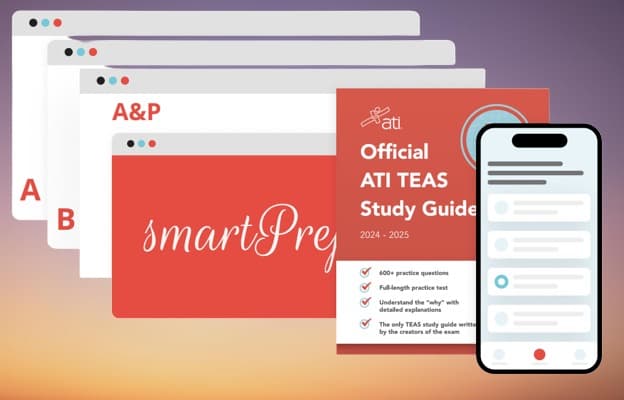Introduction
The TEAS (Test of Essential Academic Skills) is a crucial hurdle for aspiring nurses pursuing their educational goals. While the exam covers various subjects, the math section can be a source of anxiety for many test-takers. This guide will equip you with a clear understanding of the TEAS test math section, its format, and the types of questions you’ll encounter, allowing you to approach it confidently.
Format of the Math Section
The TEAS test math section assesses your basic mathematical skills applicable to a healthcare setting. It typically consists of 38 questions, although 4 pretest questions might not count towards your final score.
Types of Questions
The TEAS test math section focuses on the foundational mathematical skills needed in nursing school and your future career. Here’s a breakdown of the question types you can expect:
- Arithmetic Operations: Expect questions involving addition, subtraction, multiplication, and division of whole numbers, decimals, and fractions. Be prepared to apply the order of operations (PEMDAS) to solve problems accurately.
PEMDAS is an acronym for the order of operations to be followed when solving expressions with multiple operations. It stands for P—parentheses, E—exponents, M—multiplication, D—division, A—addition, and S—subtraction.
- Algebraic Expressions and Equations: Brush up on your basic algebra skills. You might encounter questions where you need to solve for unknowns in simple linear equations or manipulate algebraic expressions.
- Measurement and Conversions: Nursing requires the ability to work with different units of measurement. For example, you might be asked to convert metric and imperial units for weight, volume, or length.
- Ratios, Proportions, and Percentages: Understanding ratios and proportions is key to many healthcare applications, such as medication dosage calculations. Be prepared to solve word problems involving ratios, proportions, and percentages.
- Data Analysis and Interpretation: The TEAS test math section may include questions requiring you to interpret data presented in charts, graphs, or tables. You might also need to calculate basic statistics like mean, median, or range.

Difficulty Level
The difficulty level generally falls within the range of high school math, and the focus is on applying core mathematical principles to real-world healthcare scenarios.
By familiarizing yourself with the TEAS test math section’s format, question types, and difficulty level, you can develop a targeted study plan and confidently approach the exam. Remember, consistent practice and a solid understanding of the core concepts will equip you to excel in this section and pave the way for your success in nursing school.
A Breakdown of the TEAS Test Math Section by Question Types
This section delves deeper into the specific question types within the broader categories of Numbers and Operations, Measurement and Data, and Algebra.
1. Numbers and Operations:
This category lays the foundation by testing your proficiency in basic arithmetic operations. Here’s what to expect:
- Fundamental Operations: Brush up on addition, subtraction, multiplication, and division. Be prepared to handle whole numbers, decimals, and fractions. Remember PEMDAS (Parentheses, Exponents, Multiplication, Division from left to right, Addition, and Subtraction from left to right) to ensure accurate calculations.
- Number Properties: You might encounter questions that test your understanding of number properties, such as even/odd numbers, positive/negative numbers, rounding, and estimating.
2. Measurement and Data:
This section assesses your ability to handle measurements and interpret data, which are crucial skills in a healthcare setting.
- Measurement Conversions: The nursing field relies heavily on accurate measurements. Be prepared to convert between measurement system units, such as grams to milligrams for medication dosages or feet, and inches to centimeters for patient height.
- Data Interpretation: The math section may present data in charts, graphs, or tables. You might be asked to calculate basic statistics like mean (average), median (middle value), or range (difference between highest and lowest values). Additionally, questions could involve interpreting trends or patterns within the data.
3. Algebra:
The TEAS doesn’t delve into complex algebra, but a basic understanding of some concepts will prove beneficial.
- Solving Linear Equations: You might encounter simple linear equations with one variable. Be prepared to manipulate the equation to isolate the variable and solve for its value.
- Simplifying Expressions: Questions could involve simplifying algebraic expressions by combining like terms or using basic properties of exponents.
Consistent practice with these specific question types will significantly enhance your confidence and preparedness. By mastering the fundamentals, you’ll be well-equipped to tackle the challenges it presents.
Understand the TEAS Math Scoring System
After conquering the different question types in the section, let’s focus on understanding how performance is evaluated.
Total Possible Score:
The section typically scores out of 100 points.
Scoring Criteria:
Unlike some exams, the TEAS math section does not penalize you for incorrect answers. This means there’s no disadvantage to attempting every question, even if you’re unsure.
Passing Score:
There is no universal passing score for the TEAS math section. Individual nursing schools set their minimum score requirements for admission, which can vary depending on the program and its competitiveness. It’s crucial to check with your target schools to determine their specific TEAS math score cut-off.
However, generally speaking, aiming for a score of 60-70% (60-70 points out of 100) on the math section is a good benchmark for most nursing schools. This demonstrates a solid foundation in basic mathematical skills necessary for success in the program.
Why Mastering the Math Section Matters
Here’s why understanding its format and question types is essential:
- Targeted Preparation: Knowing what to expect on the exam allows you to tailor your study plan to focus on the specific math concepts and skills tested. This ensures you spend time effectively, maximizing your learning and retention.
- Reduced Test Anxiety: Understanding the format and question types before the exam can significantly reduce test anxiety. You’ll feel more confident and prepared to tackle the challenges presented.
- Strategic Approach: Familiarity with the scoring system allows you to develop a strategic approach to the exam. Knowing there’s no penalty for guessing encourages you to attempt all questions, even if you’re unsure of the answer. This can increase your score by maximizing the number of questions you answer correctly.
Having demystified the TEAS math section, format, and scoring system, let’s explore practical strategies and tips for excelling on the exam.
Study Schedule for TEAS Math Section
Here’s why a well-defined study schedule is your secret weapon:
- You get an organized Approach: Creating a study schedule helps you organize your learning by allocating specific time slots for each math topic covered in the TEAS exam. This ensures you don’t neglect any crucial areas and devote sufficient time to areas requiring extra attention.
- Consistent Practice: Consistent practice is the key to retaining information and mastering skills. A study schedule helps you establish a regular practice routine, ensuring you revisit key concepts and problem-solving techniques regularly. This repetition strengthens your understanding and builds confidence.
- You manage your time well: A study schedule allows you to allocate appropriate time slots for each topic based on its complexity and your needs. This practice run helps you develop time management strategies to replicate on the exam.
A well-designed study schedule incorporates these essential elements, empowering you to approach your preparation in a structured and efficient manner, maximizing your chances of achieving a top score.
Effective Studying Techniques for TEAS Math Section
Let’s explore techniques to optimize your learning and retention of math concepts.
- Set SMART Goals: Transform your study sessions into laser-focused endeavors by setting SMART goals. Specific, Measurable, Attainable, Relevant, and Time-bound goals provide a clear roadmap for each session. Aim to cover specific topics, solve several practice problems, or master a particular skill by the end of your study session.
- Embrace a Resource bank/study materials: Utilize various resources to enhance your learning. Textbooks, TEAS math study guides, and online practice question banks can provide in-depth explanations, diverse practice problems, and targeted assessments.
- Active Learning is Key: Passive reading might not be enough for long-term retention. Engage in active learning techniques to solidify your understanding. Summarize key concepts in your own words, explain them to a classmate or study buddy, or create flashcards for quick review.
- Fuel Your Brain and Body: Maintaining a healthy lifestyle optimizes your learning potential. Prioritize a good night’s sleep to consolidate information in your memory. Nourish your brain with nutritious foods and stay hydrated to improve focus. Scheduling regular breaks during study sessions helps prevent burnout and allows you to return to the material feeling refreshed.
By implementing these effective study techniques alongside your strategic study schedule, you’ll be well on your way to conquering the math section and taking a significant step toward your dream of becoming a nurse.
Tips for TEAS Math Section Success
Here, time management and practical problem-solving skills become your most valuable assets.
1. Time Management Strategies:
- Understand the Time Limit: Knowing how many questions you need to answer and how much time you have per question is crucial. This allows you to allocate your time wisely, ensuring you attempt all questions while avoiding spending too much time on any single one.
- Practice with Timed Tests: Simulating the exam environment with a ticking clock helps you develop a time management strategy and identify areas where you might be spending too much time. This allows you to refine your approach and ensure you complete the entire section within the allotted time.
- Skip Difficult Questions: If you encounter a question that stumps you, skip it and move on. If time permits, flag the question for review later. This ensures you maximize your score by first focusing on the more straightforward questions.
- Use a Watch or Timer: Use a watch or timer to monitor your progress and adjust your pace accordingly. Dividing your time evenly among the questions ensures you don’t run out of time before completing the section.
The Power of Time Management and Problem-Solving Skills:
Effective time management ensures you attempt all the questions, while strategic approaches to difficult problems enhance your accuracy and efficiency.
Apply these tips diligently during your preparation and on the exam day itself. With focused preparation and a strategic approach, you’ll be well on your way to conquering the math section and taking a significant step toward your nursing career dreams.
2. Approaches to Difficult Math Problems:
- Break Down the Problem: Read the problem carefully and identify the critical information provided. Then, break it down into smaller, more manageable steps. This will allow you to tackle the problem piece by piece, making it less overwhelming.
- Embrace Logical Reasoning: Analyze the problem and the answer options. Look for patterns or relationships in the numbers or data provided. Eliminate answer choices that are illogical or inconsistent with the information presented.
- Work Backwards: For multiple-choice questions, consider working backward. Start with the answer choices and see if you can plug them back into the problem to determine if they yield a correct solution. This approach can be a powerful tool for identifying the correct answer, especially for multiple-step problems.
- Check Your Work: Double-check your work, paying close attention to ensure you haven’t made careless errors, especially in calculations or applying formulas. If time allows, review all your answers before submitting the exam.
TEAS 7 Math Formulas You Should Know
Here’s a breakdown of formulas categorized by the main concepts tested in the TEAS 7 Math section:
1) Area and Volume
- Rectangle: Area (A) = length (l) x width (w)
- Square: Area (A) = side (s) x side (s) (Remember a square is a particular type of rectangle with all sides equal)
- Triangle: Area (A) = ½ x base (b) x height (h)
- Right Circular Cylinder: Volume (V) = π x radius (r) squared x height (h) *𝜋 (pi) is a mathematical constant with a value of approximately 3.14
2) Measurement and Conversions
- Converting between Units: While the section may not provide specific conversion formulas, it’s essential to be familiar with unit conversion rates (e.g., 1 inch = 2.54 centimeters, 1 pound = 16 ounces).
- Percents: Percent (%) means “out of one hundred.”: Convert a percentage into a decimal by dividing by 100 (e.g., 50% = 50/100 = 0.5). Finding a percentage of a number: (percentage) x (whole number) = result (e.g., 10% of 200 = 0.1 x 200 = 20)
- Ratios and Proportions: A ratio compares two numbers and can be written in a few ways: a:b (colon notation), a/b (fraction notation), or “a to b.” A proportion states that two ratios are equivalent: a:b = c:d
3) Basic Algebra
- Linear Equations in One Variable: For equations like ax + b = c, you can isolate the variable (x) to solve for its value. This might involve subtracting or dividing both sides by the same number.
Remember: This is not an exhaustive list, and the math section may not explicitly require memorizing every formula. However, having a solid grasp of these core concepts and the ability to apply them will significantly enhance your problem-solving skills and help you approach various questions.
The TEAS test math section may seem daunting at first. Still, with a comprehensive understanding of the content, strategic study practices, and unwavering self-belief, you’ve equipped yourself with the tools needed to excel. Thank you for using this guide. We wish you luck on your TEAS exam and future nursing endeavors!




